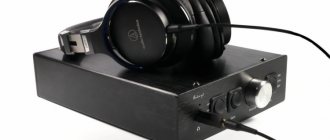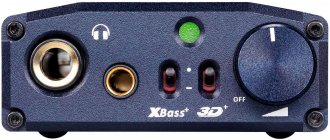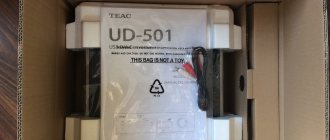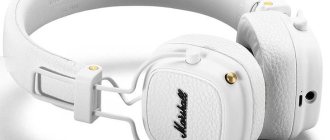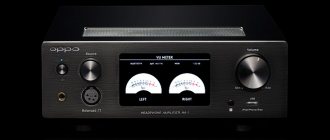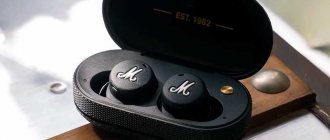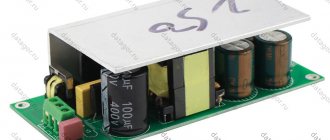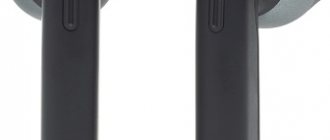Exploring more and more digital sources can make you feel bored. As before with CD players, it is already obvious that today DACs have reached a certain technological ceiling. Under the top cover there is the same thing - here is a toroid, here is a board with a converter chip and a receiver. How to make a DAC desirable again?
Well, really, what can you decorate it with? Install an even larger toroid? Such a canned food looks impressive inside, of course, but why do you need a welding machine for a signal with a swing of 3 volts? Give the opportunity to click filters? Now this is implemented at the level of the chip itself, so now any Chinese homemade device for one hundred and fifty dollars can offer similar joys.
RME equipment belongs to the professional audio segment, which is probably why there is still a certain good spirit here. The two latest ADI-2 products - DAC and Pro FS with an ADC module - I must admit, shocked me with their settings architecture and parameters. They don’t cost three kopecks, but I’m absolutely sure that for a similar technical level in a high-end household they would ask five times more. This review will differ from the traditional structure of presentation, because the study of these devices continues to this day, as evidenced by the detailed RME manual of more than a hundred pages. Therefore, let's start with the most obvious - the shortcomings of the ADI-2, half of which are imaginary.
What goes with it?
- It will become a component of a Hi-Fi system or a partner for a computer and headphones or active speakers, also providing ample opportunities to adjust the sound to the acoustics of the room or to the genre of music and the tastes of the listener.
It's hard to remember a DAC/headphone amplifier that's as elegant and attractive as this one.
The quality of workmanship and finishing is excellent. RME is a German company that has been developing and manufacturing digital audio equipment for professional use since 1996. DAC/headphone amplifier ADI-2 DAC FS is today the closest version of proprietary signal conversion devices to the needs of a simple music lover. The previous model, RME ADI-2 Pro, was still addressed to studio workers, as evidenced by the set of inputs and outputs, as well as the available analog-to-digital conversion function, which, of course, allows you to use this device as a preamplifier, but Hi-Fi purists Intermediate conversions of an analog signal to a digital signal are usually not welcomed. By removing it from the component we tested, its creators were also able to slightly reduce the cost of the product. The result is a completely formatted device, which has many analogues on the Hi-Fi market.
However, to say this means to seriously sin against the truth and offend the developers. When you get acquainted with the ADI-2 DAC FS, you get the impression that they, being great experts in digital audio and related technologies, simply could not help but share at least part of their accumulated experience and skills with ordinary users. And the love of music - the company's website says that most RME employees play one instrument or another - forces them to do everything to make it sound as authentic as possible.
The first of the mentioned circumstances led to the presence of many parameters and functions in the DAC that need to be configured, and the second led to a manic struggle (otherwise you can call it) for the signal-to-noise ratio, channel separation, reduction of SOI, etc., that is, for ideal possible characteristics of an audio component today.
The device is powered from the supplied adapter. You can also use an external battery.
Design and equipment
Small - smaller than a notebook sheet at the base - the RME ADI-2 DAC FS looks nice, but it can’t be said to be elegant: there are a lot of buttons, round knobs and connectors on its front panel. There is also a small color display to help you navigate its countless settings.
The control system cannot be called simple, however, having an intelligent user manual at hand (in English and German) and tinkering with it, after a short time you delve into the logic of its authors. Fortunately, the factory settings are such that you can start listening right away with high-quality sound, and the included remote control makes basic operation of the DAC intuitive for most who are more or less in the know.
The component receives digital streams through an asynchronous USB port and two SPDIF inputs - optical (with ADAT format support - greetings from the professionals) and coaxial. It outputs analog signals to balanced XLR and unbalanced RCA outputs, as well as two headphone jacks equipped with their own amplification circuits.
To better match with connected devices, such as powered speakers or an amplifier, the line outputs can be set to one of four output levels via the menu.
For the 6.3mm headphone output, it is suggested to select the Hi-Power option if the connected model has a high input impedance. At the same time, the Extreme Power amplification unit that serves this connector protects the headphones from excessive overloads that can lead to destruction; in particular, a special relay turns off the signal if a constant component is detected in it. It has other features found in large power amplifiers, and is also equipped with a sensor that instructs the sound processor to smooth out and stretch out the rise in volume so that the listener can react to its too high level.
The second headphone output, 3.5 mm, called IEM (In Ear Monitors), is designed to connect modern, highly sensitive earbuds with minimal impedance. The amplifier driving this output has virtually zero output impedance and a record low noise level.
Through the menu, you can configure automatic shutdown of line outputs if the device is used with headphones.
The built-in DSP allows you to change the frequency response of the device (adjust timbres, perform five-band equalization, turn on loudness), use the Crossfeed function, which makes the acoustic space formed by the headphones similar to the sound stage of speakers, change the polarity of the signal, convert mono to stereo and vice versa. This DAC also allows you to record the signal coming to the SPDIF inputs via a USB port.
Featuring a fully balanced architecture, the RME ADI-2 DAC FS is based on the AKM AK4493 digital-to-analog conversion chip. The original circuit design, developed by the company's engineers, allows you to fully realize all the characteristics of this chip: support for sampling up to 32 bit / 786 kHz for PCM and DSD up to DSD256, as well as provide amazing figures for noise level of -123 dBA, THD of -120 dB and THD+ noise at -116 dB. The six digital filters provided in it are made available to the user through the menu.
When working with a stream coming through a USB port, the built-in SteadyClock FS clock generator is used, which radically reduces noise and distortion associated with jitter.
The device has a gate array that allows you to update the software and add functions.
The display allows you to make settings, and also displays information about them and about the parameters of the processed digital stream. It can also show the instantaneous spectrum of an audio signal.
What's done for the headphones?
One of the two headphone outputs of the DAC is made using a TI OPA1622 K op-amp and a 3.5 mm mini-jack for the needs of IEM models. Unfortunately, my custom fittings were undergoing maintenance at that moment, and I had to be content with only the Audio-Technica ATH-ESW10. The Pro version has two 6.3mm output jacks that can be used for balanced headphone connections. The headphone output has two levels of amplification, and the device itself, when the plug is connected, measures the load and issues a warning if the signal for the speakers is too high.
Technical measurements of the headphone outputs (six pieces of TI OPA1688 for each) show no dependence on the load impedance - they practically do not change. Audio-Technica ATH-ESW10 sounds soft and neutral - I’ve never had anything like this before, I even wanted to add more tones. The Sony PCM-D100 headphone recorder produces a more sonorous and “tastier” sound, but its stereo panorama does not have the delicate separation of planes that RME provides.
Excellent sound in a solid system
This RME DAC can be used both as an element of a solid Hi-Fi system, and paired with a PC as an external sound card. In particular, it was no match for such solid components as the Plinius Hiato amplifier when connected to its XLR connectors and the Revel Performa F-52 floorstanding speakers. The source of digital content in this case was the Aurender A100 network player, equipped with a USB port through which the digital stream is output, and software that complies with the USB Audio Class 2.0 specification.
The sound is balanced, timbrally rich and energetic. But I would especially like to note the excellent separation of all melodic lines and the holographic prominence of focused musical images. This is not just detail, but its, so to speak, the next version. At the same time, the feed is seamless, without breaks or inconsistencies. In compositions of any complexity, each element takes its place and organically complements the others.
In “The Seasons”, interpreted by Max Richter (album Recomposed by Max Richter. Vivaldi. The Four Seasons) in MQA format from the Tidal service, acoustic instruments and electronic effects coexist in beautiful harmony. The solo violin sounds natural and emotional: sometimes soulful and melodic, sometimes harsh and capricious. The highs, when required, are very delicate and light, filled with subtle nuances. The bass line is clear and deep; in the finale of Summer 3 it appears somewhere in the depths of the stage, its low-frequency pulsations become louder and more distinct and at the end of the track they displace Vivaldi’s melodies, creating an alarming and depressing mood.
All the measures taken by the RME ADI-2 DAC FS developers to combat noise and distortion bear fruit when playing Margarita’s aria from A. Boito’s opera “Mephistopheles” performed by A. Netrebko from the Verismo album (also from Tidal in MQA). This recording has a huge dynamic range, starting with a barely audible bass introduction and reaching the apex of volume in the singer's coloratura soars. You can hear everything down to the smallest detail in both cases; the stage remains stable, instruments and vocals remain sharply focused, and the system's ability to capture subtle dynamic variations makes the presentation exceptionally expressive.
Real Hi-Res files from a hard drive connected to the Aurender A100 are played just as well. The remastered album Machine Head by Deep Purple in 24/96 format demonstrates enviable drive and agility, giving the listener of the song Highway Star the feeling of a car rushing at great speed. And at the same time, well-known songs appear authentic, without a touch of modern accents.
I was also pleased with the sound of the album Clap Hands, Here comes Charlie! Ella Fitzgerald (24/96). The “vinyl” noise inherent in it is precisely dosed - it creates a “flavor”, but does not irritate - and the singer’s voice is fluid, smooth, natural and very pleasant.
On the rear panel there are only connectors traditional for the Hi-Fi world.
The insidious "digit"
We have already noted more than once the insidiousness of digital streams: it would seem how you can ruin a sequence of pulses, but in fact they require even more subtle handling than, say, a signal from a vinyl turntable, in order to demonstrate that modern audio is still not only convenient , but also quality in terms of sound.
Having installed the necessary driver on a laptop running Windows 10 and using the popular software player Foobar2000, we continued testing the ADI-2 DAC FS - and were quite disappointed. The magical charm of the sound of our system has disappeared. In general, everything turned out well, but we already knew how it could be. When using a computer as a content source, you should always keep in mind that the operating system makes changes to the original digital data when preparing it for output via a USB port. How to deal with this is described, for example, here. However, you can also use other software players and make the necessary settings in them. With JRiver, the sound is, for example, noticeably better.
The small remote control allows you to quickly change the most important settings without having to navigate through extensive menus.
Packaging and equipment
The device is supplied in an oblong box, the outer part of which serves as a dust jacket. On it we will find a photo and the name of the device. In general, everything is standard here.
We remove it and find instructions. Quite a thick book with a certain number of pages. And this is the rare case when it really won’t be superfluous. Why? More on this later.
In addition to the instructions, the kit includes the device itself, a power supply and a remote control nearby.
Sound for every taste
Many music lovers will choose to use this RME device as a desktop component with a computer and headphones or powered speakers. I must say that it is very conducive to this: it is nice to have it on hand and “play around” with numerous settings while listening, or simply contemplate the spectrogram of the composition being performed.
Our companions at this stage of testing were the full-size models Oppo PM-3 and Neumann NDH 20. Both of them demonstrated better, in particular, more dynamic sound in Hi-Power mode, despite the low impedance of the first (26 Ohms). For the second with its indicator of 150 Ohms, it is completely required.
With the Oppo PM-3, this DAC/headphone amplifier delivers balanced, detailed, rich sound. “Koshchei’s Nasty Dance” from Stravinsky’s ballet suite “The Firebird” in 24/192 format is performed wonderfully: with diverse and recognizable instrument voices, whimsical but clear rhythm, swift attack, expressive dynamic takeoffs, powerful drum beats, light and ringing percussion . At the same time, no digital artifacts are observed, the music flows in a continuous stream, seamlessly - if that can be said about this work. The acoustic space is large, lively, filled with air, the images are precisely focused.
50 Cent's rap from the album The Massacre, namely I'm Supposed To Die Tonight, is presented impressively in CD quality, with an elastic and deep bass rhythm, excellent depiction of all elements of the composition and an articulate, expressive voice of the soloist. Oppo headphones achieve this result with factory settings, but the NDH 20 needed a +4 dB HF adjustment, quickly accessible from the remote control. Without it there was a lot of bass, but not enough detail. You can achieve even better results by using the equalizer function and spending some time adjusting the sound of these headphones to your liking. These user settings can be remembered (up to 20 pieces) and selected if necessary.
The Crossfeed feature didn't make much of an impression, and the digital filters don't have much effect on the sound, but it's worth trying each of them - each user has their own taste.
The RME ADI-2 DAC FS can handle DSD streams in DSD over PCM (DoP) and Native formats. In both cases, DSD-encoded data is delivered to the input of the AKM AK4493 DAC chip in its original form without intermediate conversion to PCM, and all DSP effects are disabled.
The digital volume control built into the AK4493 (as well as all other modern DAC chips) can only work with PCM, so the DSD stream is automatically converted into it by the chip itself. For those users who would like to eliminate this “extra” conversion, the developers recommend activating the DSD Direct mode in the settings. In this case, the volume control is disabled, as well as the headphone outputs, and the analog signal is sent only to the line outputs.
However, Jazz At The Pawnshop sounds great in DSD128 and when converted to PCM at 176.4 kHz on headphones, with the inherent fluidity of this one-bit format.
Settings Tricks
And the number of intellectual capabilities in ADI-2 is incalculable. The volume is adjustable on a full digital scale down to 0 dB, and the user can relay switch the four levels of gain of the analog stages. This is very convenient when matching a source directly to active speakers or a power amplifier. According to technical data and measurements, all cascades look almost the same, but it seemed to me that the final character of the sound is still different. This may be due to the quirks of the input sensitivity of the amplifier and AV receiver. For certain soundtracks, such as classical music, it is better to set the gain to minimum and volume to high. The scene seems to grow in depth. And recordings that are more compressed in volume will sound with more punch on a high gain stage, but with the volume knob twisted back. Miracles and psychoacoustics!
The signal in RME can be manipulated and configured separately for headphones and outputs: invert in phase (including in one channel) and in mono, create loudness compensation and five degrees of crossfeed, which is useful for old stereo recordings, assign SRC resampling (using the internal AKM converter AK4127VF) and complex parametric equalization of both input and output signals. The latter is useful not only for room correction.
As you know from the specifications, our glorious AK4490 chip has 5 filtering options. Two of them - Slow and Super-Slow (which RME lists as NOS) - have a very clean impulse response, without spurious ringing, but at the same time they suffer from a roll-off in the frequency response and the release of alias noise. This is always the case with digital filters. There is only one thing that is beautiful - either the linearity of the frequency or the phase.
The main developer of RME, Matthias Carstens, calculated and proposed equalizer presets that tighten the frequency response of the Slow and NOS filters to the line, while adding just a little ringing to the impulse (see figure below). At the same time, he himself does not sit in an ivory tower, but is present on the company forum, collecting comments and suggestions, some of which are then implemented in the new firmware.
RME's digital internal mathematics is top-notch and there is no need to worry about signal interference. The standard SD-Sharp is also good in its own way, especially in headphones, but the final harmony of the sound with preserved detail was provided by the NOS (Super-Slow-filter) option plus EQ compensation recommended by Carstens.
Let's sum it up
Perhaps, in this, and in a significantly higher price segment, the RME ADI-2 DAC FS has no competitors either in terms of equipment or sound quality. Perhaps its cost is due to the period of entry into a new market for the company, so digital audio lovers looking for a DAC/headphone amplifier should hurry up with their purchase.
All equipment was tested in Audiomania showrooms How we test Hi-Fi components
January 2022
This review has been read 7,183 times.
